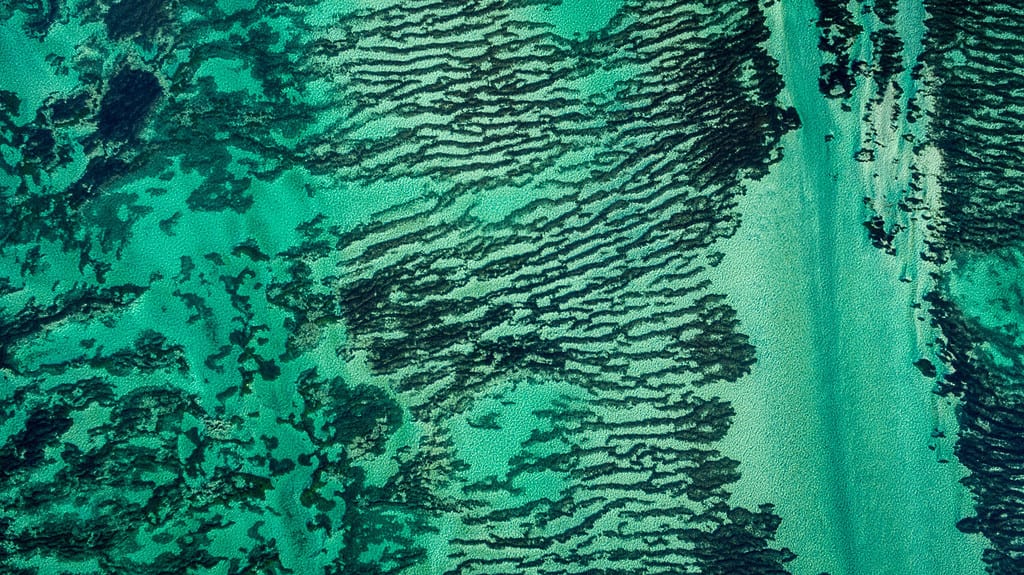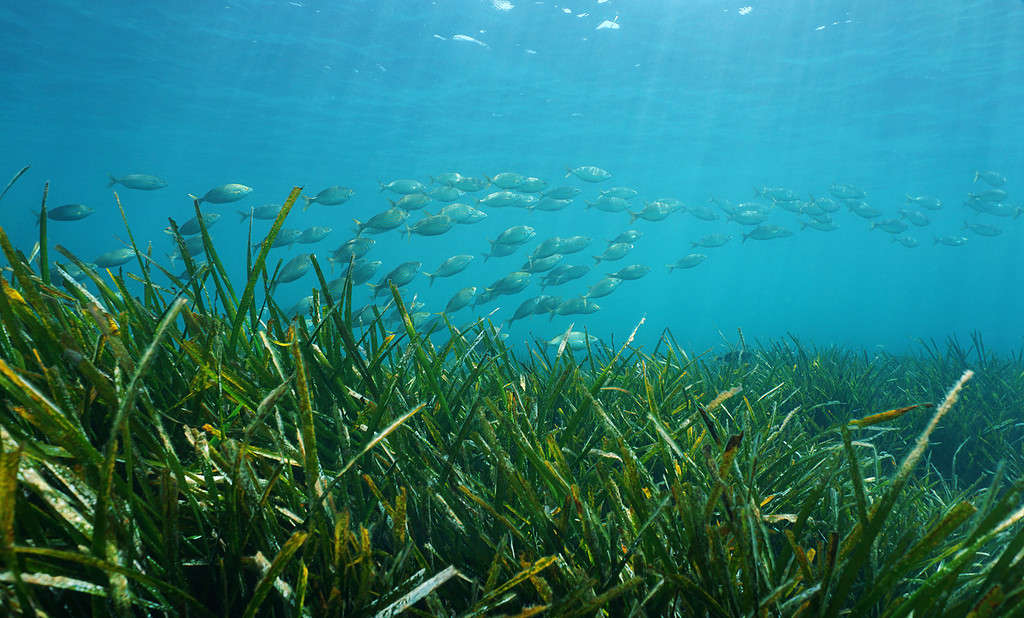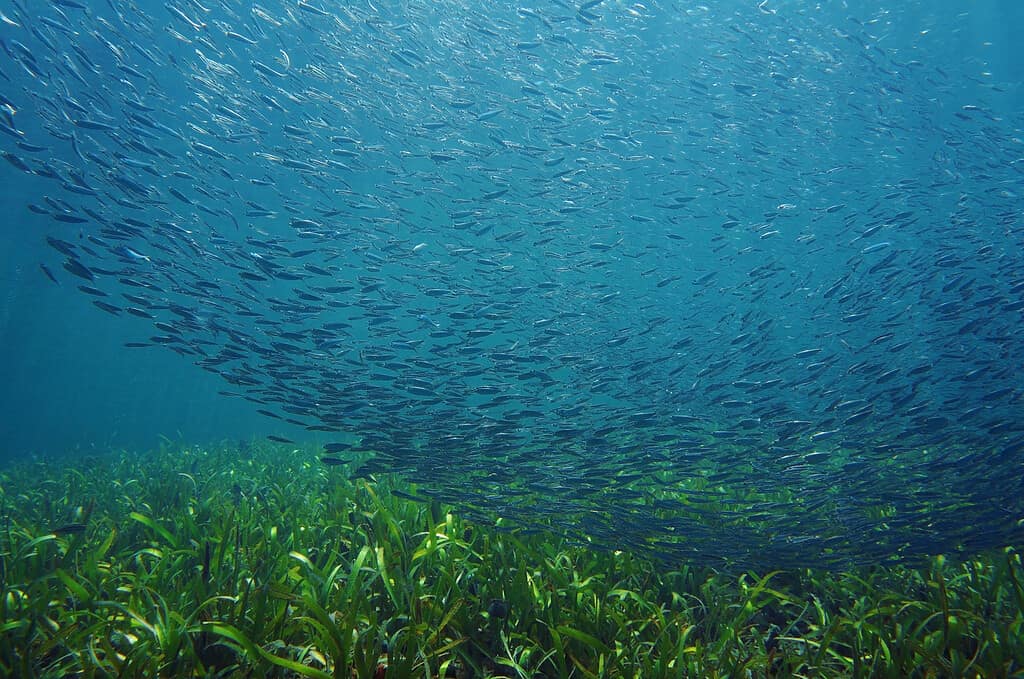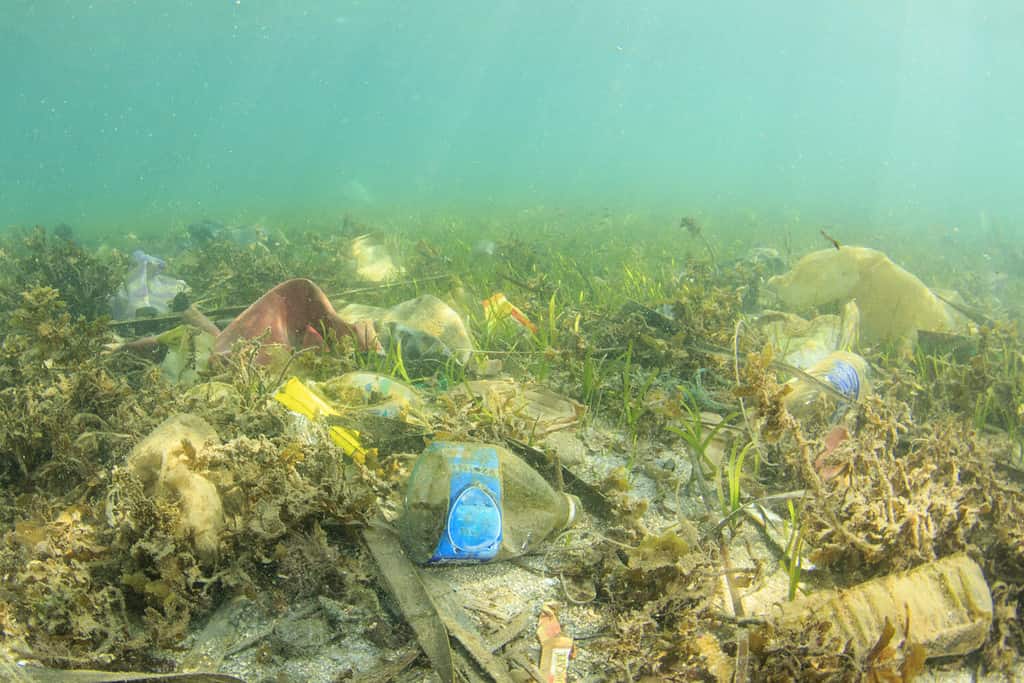
Seagrass beds are thick bunches of underwater plants that are usually close to the surface of the water.
©Damocean/iStock via Getty Images
Seagrass beds are a terribly important habitat. Despite that, they aren’t as well known as some others such as forests, deserts, and wetlands. These underwater habitats aren’t only valuable for the environment and wildlife, but for people as well. Humans have depended on seagrass for thousands of years now.
If that’s not enough to convince you of the importance of seagrass beds, continue reading below to find out more about them, including what makes the beds their home and how humans, animals, and the environment depend on them.
What Are Seagrass Beds?
Seagrass beds are areas where there is a lot of seagrass in one place. Usually, in a seagrass bed, the grass needs to take up a lot of space and be fairly dense.
Seagrass, despite the name, isn’t actually grass or seaweed. They are instead flowering plants. Seagrass is much more closely related to flowering plants you would find on land than anything you can find in the sea.
They have leaves, stems, flowers, and roots, much like a traditional plant. They may look like seaweed on the surface, but they are in a group of plants called monocotyledons. Lilies, palms, and grasses all fall into this category. There are some differences between them and other monocotyledons, as the seagrass had to make adaptations for living in the sea.
They are true plants, and as such, are the only true plants that can survive when entirely submerged under the water.
There are an estimated 72 different seagrass species in the world. These 72 species fit into five distinct groups. These groups are Zosteraceae, Hydrocharitaceae, Posidoniaceae, Cymodoceaceae, and Ruppiaceae.
The different species of seagrass are all quite different from one another. Some are small-bodied with thin, rounded leaves and lots of flowers. Others are big, with thick leaves that are narrow and look a lot like grass and don’t flower very much. One seagrass species managed to grow as tall as 35 feet. It’s known as Zostera caulescens and is frequently found in Japan.
Where Can You Find Seagrass Beds?

Seagrass is much more closely related to flowering plants you would find on land than anything you can find in the sea.
©Philip Schubert/Shutterstock.com
Seagrass beds are in salty and brackish water. They are most commonly found in oceans, though they also grow inside estuaries.
Seagrass can live fully submerged in water. However, because they are still plants, they need enough light to produce. This means that they don’t do as well in deep water. You’re much more likely to find them surrounding the coasts of beaches. Seagrass does best in depths between three and nine feet, but some scientists have found seagrass to grow in depths as low as 190 feet below sea level.
Some of these dense patches in shallower water are big enough to be clearly seen from space. The seagrass bed off of the Australian coast in Shark Bay is considered to be the largest plant in the world. It covers over 43 hectares.
You can find seagrass beds along almost every coast in the world. They stay away from the extreme north and south of the globe. They also aren’t found very much around South America or the west side of Africa. Antarctica is the only continent that doesn’t have any seagrass beds around it.
In Florida alone, there are an estimated 2.7 million acres of seagrass beds. They are most commonly found between Tarpon Springs and Apalachee Bay. They can also be found in various lagoons and bays as well as in the Gulf of Mexico.
The Indian Ocean has some of the highest diversity. There are an estimated 14 species located in the area. The western Pacific Ocean also has some pretty impressive biodiversity for the seagrasses. The rest of the world only has one or two species in any given area.
How Do Seagrass Beds Benefit the Environment?

Seagrass changes the habitat it occupies and makes it into something unique and beneficial.
©Damocean/iStock via Getty Images
Seagrass is known as a foundation plant species. These are species that change the habitat they occupy and make it into something unique. While this mostly has benefits for the seagrass species itself, it creates unique habitats for animals and has beneficial ecological functions as a by-product.
Carbon Sinks
Natural areas throughout the world that absorb carbon are often called carbon sinks. Rainforests and peat marshes are two areas that have been protected heavily due to their carbon absorption. However, mangroves and seagrasses absorb carbon at a much higher rate. They have the potential to absorb carbon five times faster than peat and forests.
Based on the seagrass beds currently in the world, over 182 billion pounds of carbon is captured by seagrass annually. To put it another way, the 0.1 percent of the ocean floor that is made up of seagrass holds 11 percent of the total carbon in the sea. One acre of seagrass alone holds 740 pounds of carbon a year. That’s the same amount someone would use if they (somehow) managed to drive From Prince of Wales Island in Canada all the way down to Cuba!
As for the oxygen they release, an 11-square-foot patch is said to produce over 2.5 gallons of oxygen a day.
Nutrient Absorption
Another benefit of seagrass is its ability to absorb nutrients. The leaves manage to absorb high levels of nutrients and slow down the movement of water in the area. This traps particles of sand and silt, which then get held in place by the roots of the plant.
By trapping sediment, the seagrass can help protect against storms and erosion as well as improve water clarity. For the nutrients, they absorb excess nutrients. In areas where nutrients are low, they pull it out of the soil and release it into the water.
How Do Seagrass Beds Benefit People?
People have used seagrasses for over 10,000 years. People on the coasts have used them for almost everything. They work as bandages, roofs, stuffing for pillows and mattresses, insulation, and fertilizer. They were even made into car seats.
Those are the direct ways that seagrass and seagrass beds help people. However, that’s not all they do. They also have an indirect effect. Because there’s a high level of biodiversity around seagrass beds, they help to support commercial fishing.
Seagrass is widely known for having extreme biodiversity. It’s often the first place that commercial fishers will go to get large catches.
When given a value, they are estimated to have a worth of over $19,000 per hectare per year. For those struggling to understand the size of a hectare, that’s about the size of two football fields. In Australia alone, seagrass beds are said to contribute enough to be worth $104 million a year.
How Do Seagrass Beds Help Animals?

A shoal of small fish swimming together over the seafloor with seagrass is just one example of animals you’ll see near this habitat.
©Damocean/iStock via Getty Images
Though they are a habitat not well known by the majority of people, they are considered to be one of the most productive ecosystems in the world. They provide both food and shelter for many marine wildlife species.
Due to how many young animals take shelter in seagrass, they are often called nursery habitats.
Seagrass even benefits algae and microalgae that take root on the leaves of seagrass. An acre of seagrass can have millions of animals in it. Based on site surveys in various seagrass patches, there could be upwards of 50 million invertebrates, 40,000 fish, and hundreds of other animals in just one acre.
Animals You Can Find in Seagrass Beds

Seagrass provides both food and shelter for many marine wildlife species.
©Damocean/iStock via Getty Images
So many animals live in seagrass beds for at least a part of their life that it’s impossible to list them all. Seagrass is a great habitat for small invertebrates and animals that don’t move, like sponges, sea anemones, crabs, shrimp, and clams.
There are plenty of larger animals that come to nurse, eat, or rest in seagrass beds. Some animals you can easily find hiding in the leaves are:
- Dugongs
- Octopuses
- Squid
- Manatees
- Sharks
- Fish
- Turtles
- Snails
- Cuttlefish
And you won’t find just one or two species of these animals hanging around. Various species for each category can easily be found hanging around. Quite a few animals that spend their adult lives in coral reefs start in seagrass beds.
Threats to These Beds
Despite all of these benefits, it doesn’t seem like seagrass beds will be around forever. They are currently being lost at a rate of 1.5 percent a year. Remember the hectare we talked about earlier? One of those is roughly lost every hour of every day.
About 25 percent of all species of seagrass are either threatened or near threatened. This is worrying, especially because for each species of seagrass threatened, there is a threatened marine animal that will be negatively harmed by the loss.
There are several threats to seagrasses. One is invasive species. Other plants that can handle the poor conditions better will start to out-compete seagrass and take over the habitat. Diseases further weaken seagrass and make it easier for competing species to take over.
Seagrass doesn’t do well in warmer temperatures as it increases the number of diseases. It also influences how much oxygen that plants have to use, as well as how much light and nutrients they need.
Another threat is physical disturbances. This is a natural loss, caused by animals ripping the plant up by the roots. Heavy storms and waves can also rip the plant out of the ground.
While seagrass can absorb a lot of nutrients, there are still so many pollutants and fertilizers going into the water that they can’t keep up. In areas with an excessive amount of pollution, the pollution blocks light and smothers the plants.
Anchors from boats end up leaving scarred areas of soil where plants no longer grow. This promotes erosion and fragments the environment. Overfishing plays a role as well. Without fish there to eat the smaller animals, the smaller animals can take over and eat up the seagrass.
Restoration Projects in Place

Daily trash ends up in the ocean and hurts wildlife and seagrass beds.
©Rich Carey/Shutterstock.com
There’s a lot of difficulty that comes with protecting seagrass. Because it’s in the ocean, and it’s a global problem, countries and rules have to come together to agree on a way to start protecting the various species.
Still, that doesn’t mean nothing is being done. A lot of the coasts in the US have great success stories. Thanks to the dedication of workers and volunteers to seed and transplant farm-grown seagrass, there have been a few hundred acres that have been replaced.
Scientists are also focusing heavily on preserving the diversity of seagrass in the ocean. This means there is a reach to protect as many species as possible, instead of just one or two that are easier to save.
Some other methods to protect seagrass include preventing trawling and dredging from fishing boats, stopping runoff from farms and rainwater, and picking up and stopping as much littering in the water as possible.
There’s still a long way to go, but the several success stories with small patches of seagrass beds have shown that it’s entirely possible to restore with enough work.
The photo featured at the top of this post is © Damsea/Shutterstock.com
Thank you for reading! Have some feedback for us? Contact the AZ Animals editorial team.






